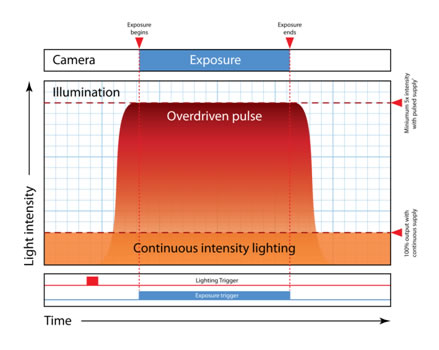Overdriving LEDs
At their specified current rating, LEDs and LED Lights output 100% brightness. However, it is possible to obtain more than 100% brightness by driving with more current rating for short pulses. This LED overdriving, in conjunction with Gardasoft SafePower™ and SafeSense™ technology, enables users to do this with ease and complete confidence.

Overdriving is used with pulse lighting and it brings benefit to most Vision applications. The exceptions are applications where the camera is exposed for a high percentage of the time, for example Linescan illumination applications.
Converting a constant illumination system to pulse illumination is straightforward. The trigger for the camera is sent to an LED lighting controller. The controller provides precise pulse width timing, power and brightness control for the lighting pulse. This ensures that the lighting pulses during the camera exposure time and that the light energy is the same for every image.
Accurate overdriving of LED lights
For applications where the user wishes to overdrive LEDs, controlling the current is especially critical. To overdrive a light by a factor of 2, you double the current. To overdrive the light by a factor of 5, you increase the current by a factor of 5. But this level of accurate overdriving is not possible with a voltage based driver - increasing the voltage will not relate to a directly proportional increase in the current, so for example, some lights might need 28V for twice the level of brightness, others might need 40V.
Safe overdriving of LED Lights
Accurate LED overdriving is a major step forward in LED lighting control, equally it's important to ensure that too high a duty cycle is not selected. Gardasoft removes this potential with its patented SafeSense™ technology. When a light is connected, the Safesense™ technology runs a very rapid routine that determines the actual rating of the light.
APP930

